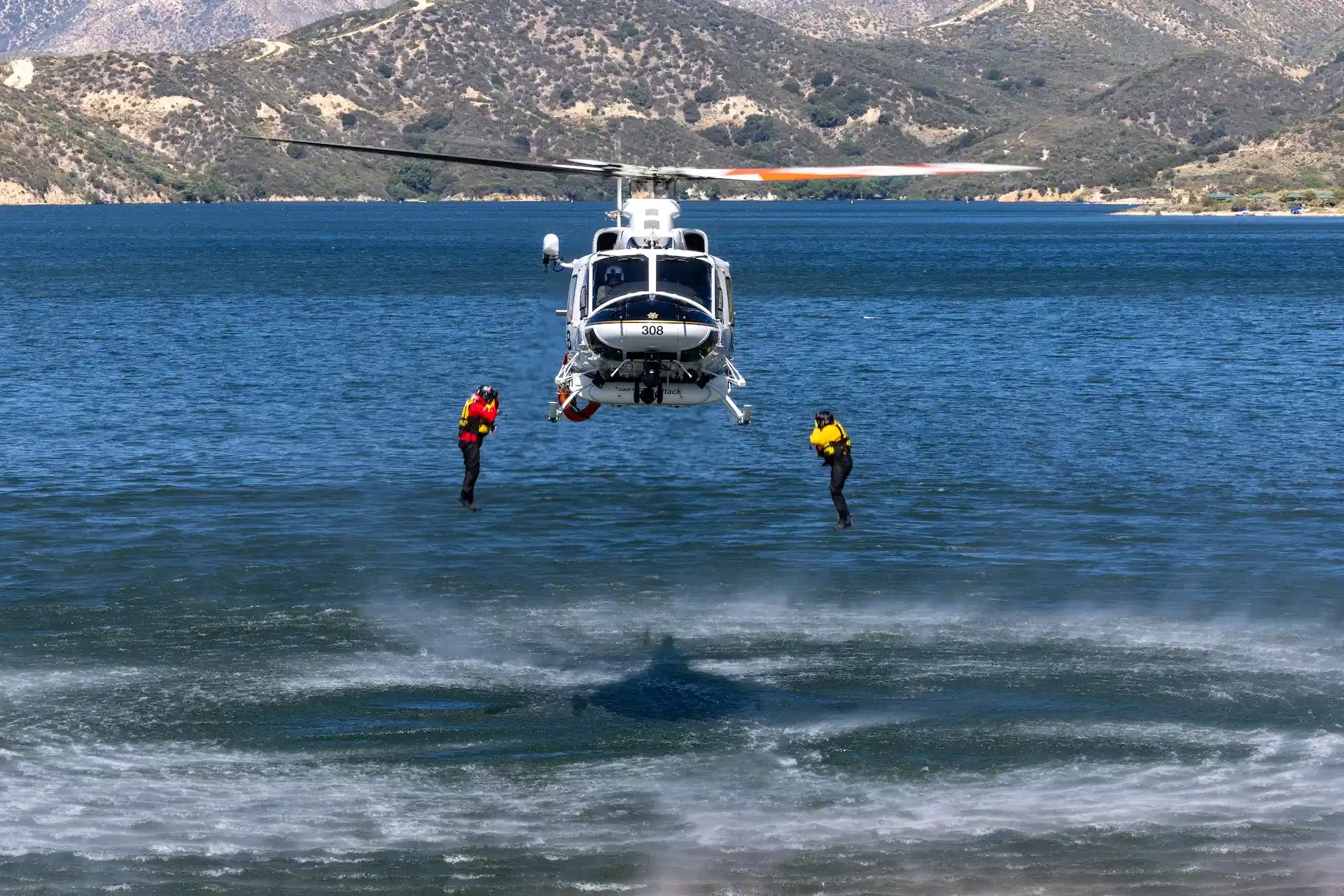The aviation unit of San Bernadino County Sheriff’s Department is the lead aerial law enforcement agency for the county. The addition of two new Bell 412EPXs increases the department’s aerial capabilities, particularly in the search and rescue role.
The Sheriff’s aviation bureau started in 1972 with a pair of turbocharged Bell 47Gs and grew over time to eventually include H125s, an AS350-B3, Bell UH-1H Hueys (205s) and a Bell 212. The big Bells were all Vietnam-era aircraft, with the Hueys being ex-military while the 1976 212 is owned outright by the department.
Modernization
Sergeant Jon Anderson of the aviation bureau has served more than 20 years as a law enforcement officer and has between 7,500 and 8,000 hours of flight time. He explained that the department first started looking at moving to a more modern platform about eight years ago and commented, “We were flying fifty-year-old Vietnam-era aircraft which has inherent problems due to the age of the airframes.” The fleet upgrade took a major step forward about four years ago when the process of due diligence commenced, with the bureau looking at the different platforms available, determining which would suit its needs at the altitudes and temperatures of its typical mission profiles. “We looked at a variety of platforms including Black Hawks, the 412 and the H145. We requested that we stay with a Bell platform – specifically the EPX. We’d looked at the EPI earlier but it didn’t have the performance we needed and when the EPX came out it was a game-changer,” Anderson related.

Factors that led to the choice of the 412EPX included the bureau’s history of flying Bell product, which meant that executing the mission for the crew chiefs and rescuers in the rear of the aircraft changed very little. The EPX also offered the best performance for the money out of the various platforms that were considered. Airbus arranged for the San Bernadino pilots to fly the H145 in their own area and Anderson observed that while it is a very good aircraft, it didn’t match the performance of the EPX. Anderson related that when Bell demonstrated the 412EPX to the bureau during high mid-summer temperatures, it was loaded slightly heavier than normal with five mechanics, two pilots and 1,200lbs of fuel and still maintained a 50ft OGE hover at around 10,500ft on Mt San Gorgonio with a margin of power to spare. “Having Bell come out and demo’ that aircraft to us in those conditions helped sell that machine to us,” he commented. “The Super Huey could do that but it’s only single engine and single hydraulics, so the added safety factor in the twin-engine, dual hydraulics 412 is significant.”
“This and previous sheriffs have been very strong supporters of aviation and understand our mission so even though the capital cost of new 412s comes with a degree of ‘sticker shock’, they understood the need to move to more modern and dependable aircraft,” Anderson stated. “I’m not saying that the 1968 and 1971 Hueys haven’t been reliable, but they’re getting to an age where they need a lot more TLC.” The new aircraft are not patrol aircraft, but replacements for those in the rescue, firefighting and tactical roles and Anderson noted that the original intention was always to seek acquisition of multiple airframes to standardize the rescue fleet. “Even though the rescue aircraft are all Bells, having three different types that you have to chop and change between can be somewhat problematic. There’s the different switchology and you revert to your training when something goes wrong so you have to then remember which aircraft you’re in, so the idea was to get a unified fleet.
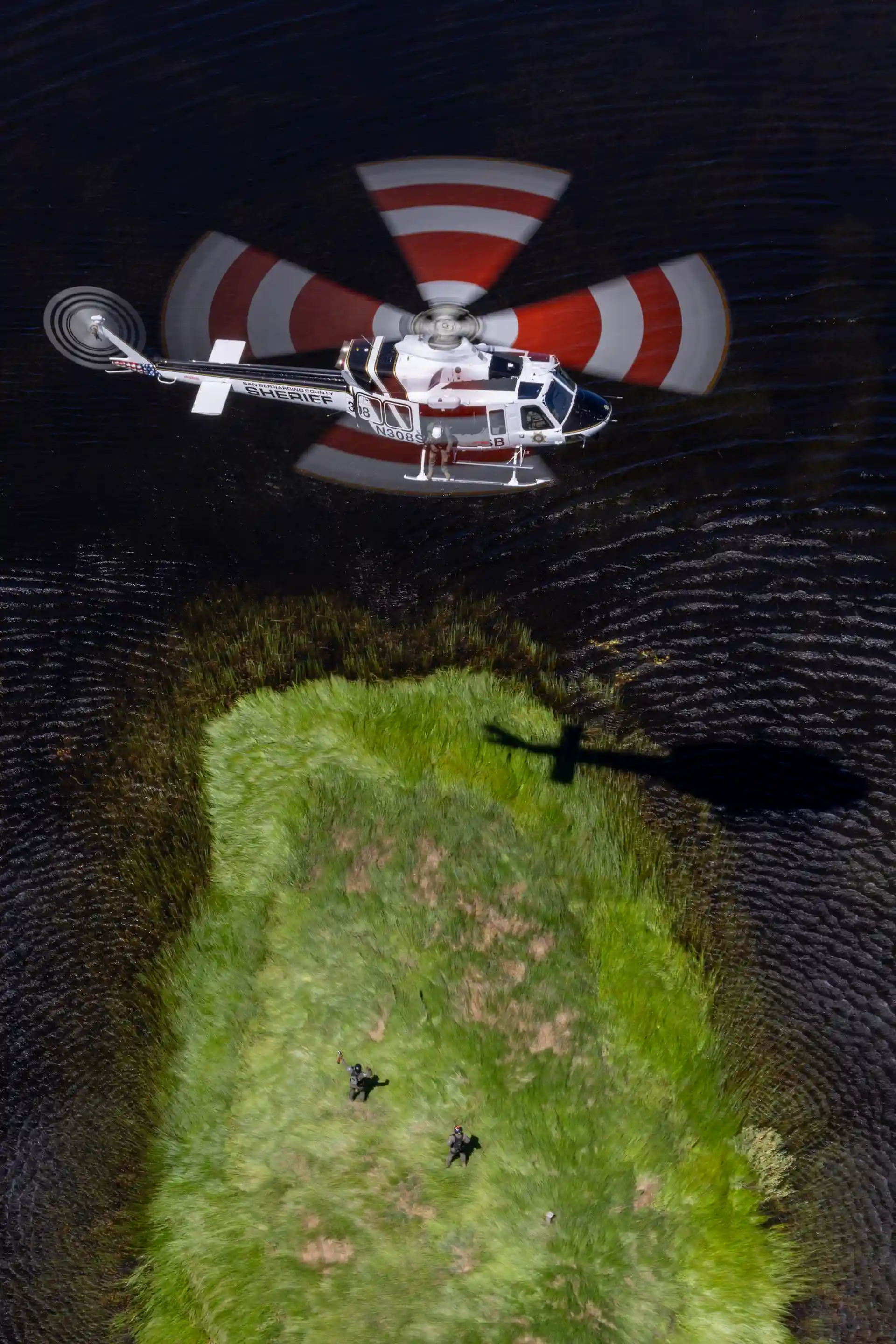
EPX Chosen
Approval came for the purchase of one new aircraft, with the intention of then retiring the lowest performing H-model Huey. The first 412EPX was delivered in early April this year after being in the completion process since July 2023. During the next fiscal cycle, the Bureau asked for approval for a second EPX and a serial number fortuitously became available for a new machine that another purchaser had pulled out of. Purchase approval was subsequently granted, and Anderson explained that the bureau will now primarily operate the two 412s and retain the 212 as a backup, giving back the old surplus aircraft at a later date. The second new aircraft is currently undergoing completion and is due for delivery around August this year.
The new 412s add significantly to the bureau’s capabilities. The older 205s were not equipped with computers, cameras or light systems, while the 212 is fitted with an older Aero-Computer system. At around 21,000 square miles, San Bernadino County is the largest county by land area in the US, so it was desired that the new aircraft be equipped with new-generation camera and light systems. “The Hueys only had about two hours endurance so if we had a rescue that first required a search, a patrol ship would be dispatched first to conduct the search for the victim and the Huey would then launch to conduct the rescue and recovery. The 412 has a much greater payload, able to fuel for an endurance of around three hours, so our goal now is to be able to conduct both the search and the rescue in a single flight,” Anderson advised. Not only will this make SAR missions more efficient, but it also frees up the patrol asset for its regular missions.

Rescue Role
The primary mission for the 412s is air-rescue, with a rescue shift of 0800 – 1800, seven days a week and a rescue crew is on call outside those hours, while firefighting is a secondary role. “There are a few hot spots for rescue missions, predominantly down in the south-west corner of the county, although they’re not always down there. There’s a lot of activity down at Dep Creek hot springs where it gets very hot all day down in a valley. People are there all day and then try to hike out and have all sorts of issues so we’re there quite frequently. Another hot spot is Mount San Antonio because it is easy to get to for a novice but quite demanding for a hiker, with a summit at around 10,500ft so you get people going there who are not prepared for the conditions – especially in the winter. You can ride a chairlift to the beginning of the Devils Backbone trail in flip-flops and shorts, but it’s a narrow trail that gets iced over. If you slip and fall, you’re going down thousands of feet, so you really need to be a well-equipped and experienced hiker to tackle it,” explained Anderson. He added that San Gorgonio Mountain is 1,000ft taller with similar conditions but, because it is more difficult to access, rescue calls to it are less frequent. Most rescue calls in those areas result in hoisting, as there are few suitable landing areas and Anderson commented that most hoists are carried out at between 8,000 and 10,000ft. An average year currently sees the unit carrying out around 150 rescues and that number has peaked at times to 300 or more, so the need for dedicated rescue ships is obvious.
Tactical missions supporting SED (special enforcement division) operations are also of primary importance but are required far less frequently than rescue or fire missions. Tactical flights are often primarily so that the helicopter is on hand in the event that Sheriff’s Office personnel are injured but can also include aerial sniping or deployment of SED personnel if terrain or distance require it. Although the current firefighting contract with CalFire is CWN, he advised that the bureau’s standard protocol for firefighting is initial attack and that if a fire or smoke is seen, they launch and go, rather than waiting to be dispatched. “It’s our county and we have responsibilities and capabilities so we self-dispatch rather than wait for CalFire to call us. If it’s in our local mountains, a lot of the time we’ll be the first asset on scene,” he remarked.
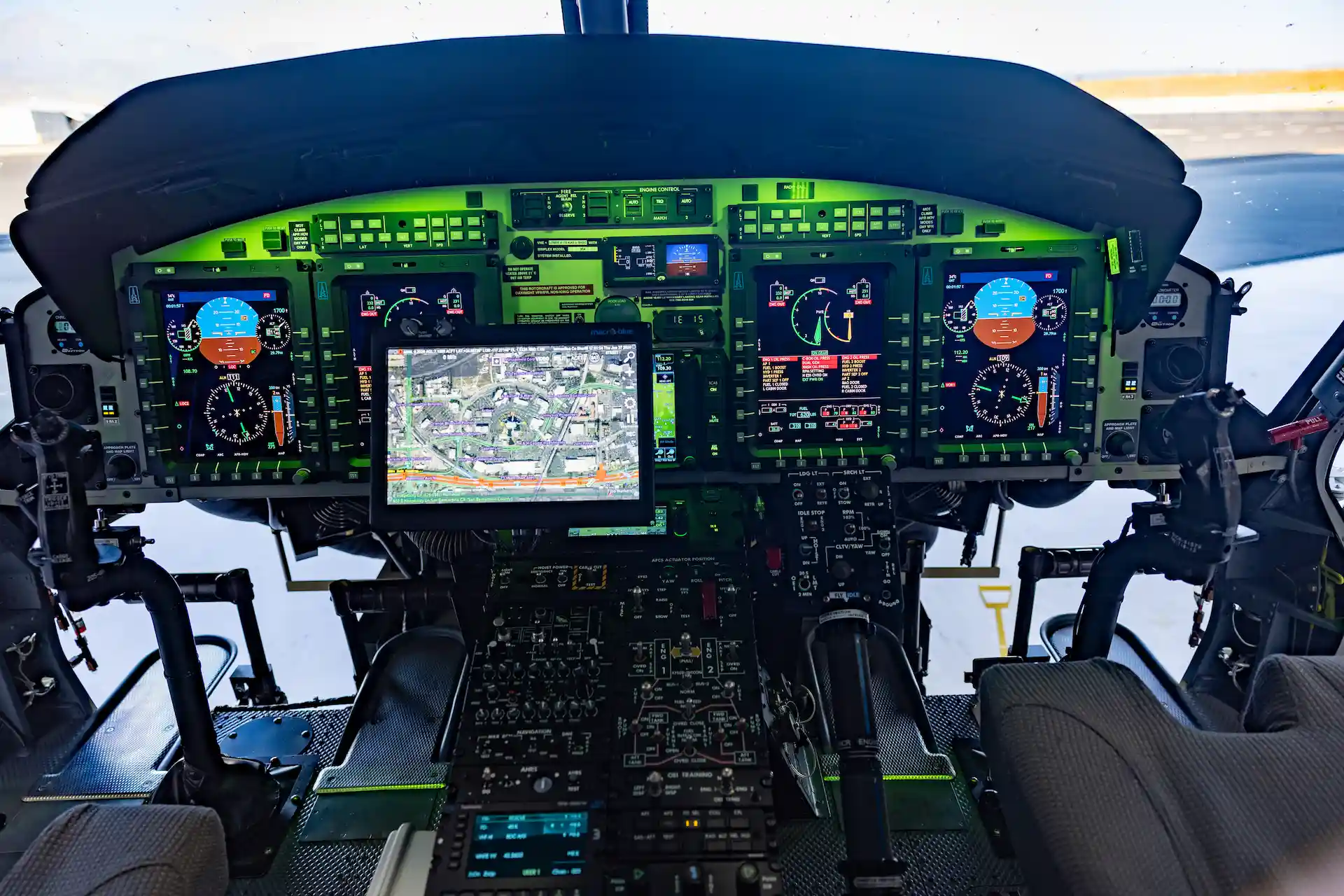
All Weather
One of the most significant additions the 412EPX brings is the introduction of an IFR capability. “The 412 increases what we can do because before now we did not have an IFR-capable platform,” said Anderson. “We sit in the valley here and there are times when we’re socked in by weather, but we have a rescue above the cloud layer in the mountains that we can’t get to. If we don’t have the desert ship on at the time, it’s going to have to wait, use ground resources or we could reach out to L.A. County for their assistance. It would be nice to be able to take care of our own though.” Although the 412EPXs are IFR-capable, Anderson advised that an IFR mission capability is still some way off as crew qualification and training is yet to be completed. “Now we have the ship and a few pilots who are IFR rated, but we have to get everybody up to speed. We have an eighteen-month to two-year goal for that, so then we can get above the cloud layer and effect a rescue.”
Mission equipment in the new EPXs includes the low-weight Wescam MX-10 EO/IR imaging system, integrated with Trakka Systems’ mapping and video management system. Completion on the 412s was carried out by Hangar One in California. According to Anderson, Bell was reluctant to complete the aircraft due to the number of aftermarket products and suppliers that were involved in the fit-out and the job was put out to tender. Hangar One submitted the only bid, which worked out well for the bureau as it is located much closer than Bell’s Texas facility. Therefore, in the event of an equipment failure or warranty issue resulting in an unscheduled outage, the timeframe for rectification is minimized. “We’ve worked with Hangar One in the past and they’ve done great work for us on our patrol aircraft completions. They’re always really busy but have been very responsive to us when we’ve needed them,” Anderson added. Bell did however paint the new 412s, including the bureau’s specialized artwork, flags and logos and Anderson had high praise for the finished result.
Ken Piland at Hangar One worked closely with bureau personnel when designing the layout and specifics of the interior completion, with his final result including a clever and space-efficient removable dovetailed post for mounting a 12-inch Macro-Blue touchscreen monitor on the center pedestal between the main cockpit displays. This swivels so it can be viewed from different positions and allows the crew chief or co-pilot to operate the camera, Shotover moving map and Trakka systems without being in the right-side rear of the cabin, where another 12-inch Macro-Blue is installed for the same functions. Although both monitors are touchscreen, a wired keyboard is also equipped and can be fitted to either the front or rear screen, as can the camera controller. Cabin camera and tail camera images can also be displayed on the Macro-Blue screens, while hoist camera imagery can show on the Macro-Blues or the co-pilot’s number two display unit. The system can record two inputs, so it is currently set up to record the hoist and cabin cameras, largely for training purposes.

Replaceable carbon-fiber floor panels from Alpine Aerotech protect the 412s’ original floor panels from damage. Unlike the internal hoist on an articulated arm that is fitted to the older aircraft, the new machines are fitted with an external Goodrich hoist. While this configuration loses the benefit of being as easily able to swing the patient into the cabin, Anderson pointed out that it frees up a significant amount of floor space in the cabin. The change means that it is easier to bring the patient on board and seat them against the transmission wall facing forward, instead of having the rescuers seated there as is done in the older birds. The rescuers are now seated facing aft, while the crew chief’s seat is in the right gun-well seat, also his normal working position for hoisting activity. A change that has only commenced implementation in the last few weeks is a shift from the Stokes Litter to rescue bags, as this frees up even more space on the cabin floor when recovering an incapacitated patient. This is a highly unusual configuration for a 412 interior but works extremely well, with the crew chief’s position accessing the hoist, the camera and mapping systems and remotes for the same radio package that is fitted in the front of the aircraft. “That lessens the workload for me on rescues or fire missions because he can manipulate and operate those radios from the back, something that we can’t do in the Hueys.
Experience with the ex-military machines led to one oversight that had to be addressed during the completion and Anderson explained that it had been assumed that the new aircraft would be produced with the same ceiling-mounted hardpoints that were in the old aircraft. This was not the case with a new civil machine so one fixed hardpoint was subsequently fitted to the right side of the transmission wall and a movable hardpoint device can be fitted to either the same location or between the rescuers’ seats. Because it was known quite early that there would be two new aircraft, completion of the second aircraft will be faster than the first, as two of everything necessary were fabricated in preparation and all the research and design work was carried out during completion of the first example.
The 412s are fitted with a stability augmentation system, something none of the older aircraft have and Anderson commented that that system alone noticeably reduced pilot fatigue levels when conducting extended hoist operations. The new aircraft also boast air-conditioning, another feature lacking in the 205s and 212, an important feature when it can get up to 115 degrees (460C) in the summer. They have a tail camera so, even though the crew chief is still calling the clearances, the pilot has greater confidence from having the additional camera view. Night operations are flown under NVGs and the 412s are fully NVG-compatible. Firefighting uses a Simplex tank and the Kawak Aviation electric hover pump, whereas the Hueys use a slower hydraulic pump. “That Kawak pump is really fast and strong,” Anderson remarked.
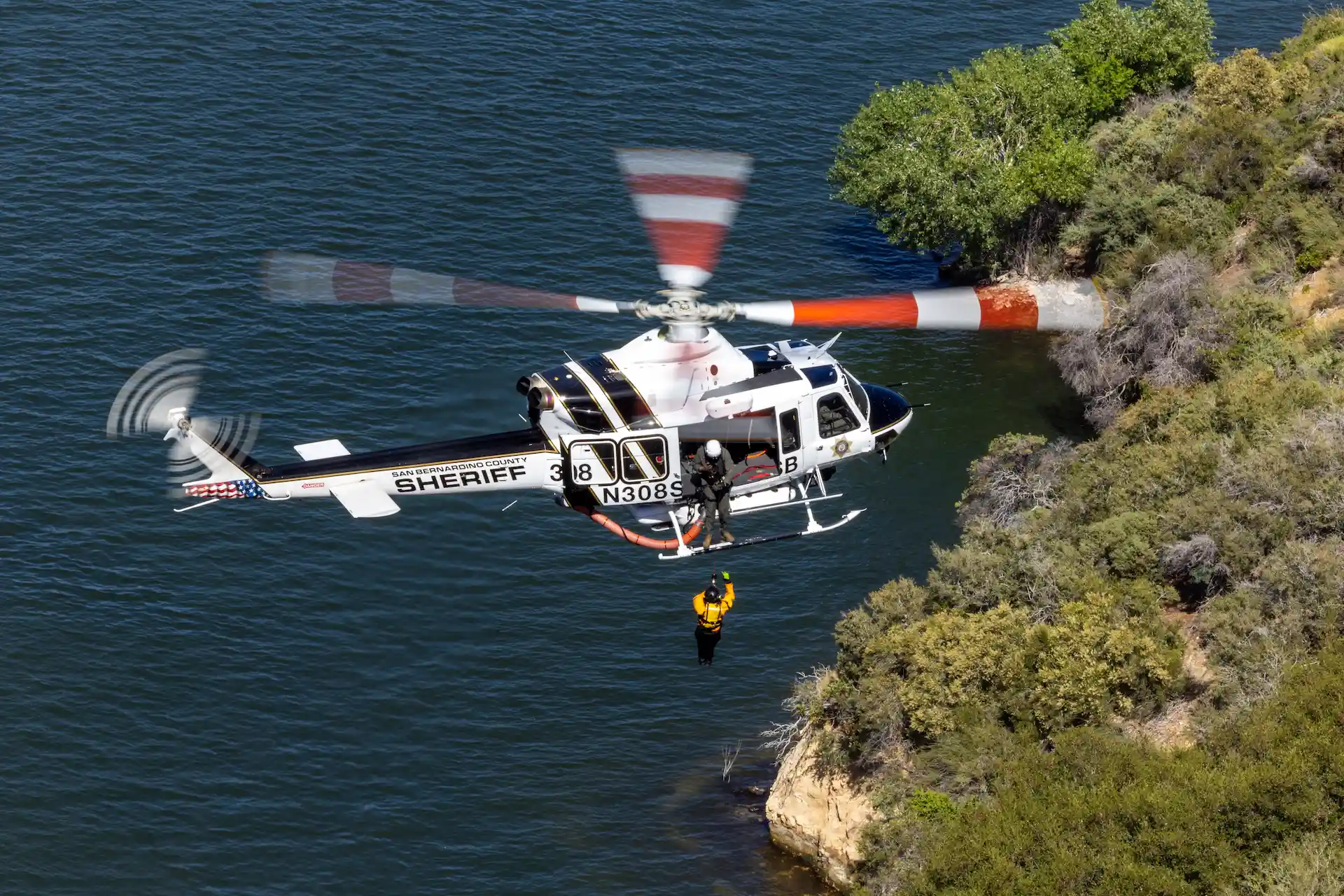
Crew Training
After the first ship was delivered in April, crew training took up May and the aircraft was then due for its first maintenance cycle, which took up two weeks in June. Anderson noted that since then, the focus has been on ensuring that everything on the new machine is working the way they want it. The rescue pilot roster currently includes four regulars and one reserve who are rated on the 412. Training is always constrained to an extent by budgetary considerations, but Anderson stated that the department recognizes the need and has provided funding for a significant amount of training. Pilots all get annual recurrency training on both the patrol and rescue platforms, and the department has a contract with Flight Safety for simulator training. Pilots alternate each year between Flight Safety simulator training and flight school full-touchdown training at HeliStream, with half going to each provider. “One of the great things about Flight Safety is that, quite coincidentally, they modelled our area, our airport and our mountains in their simulator program, which really adds to the realism of that training.
Additionally, in-house annual training is conducted for all pilots on each airframe type they fly, and for both day and night (NVG) operations so a fully qualified pilot flying rescue and patrol will be doing in-house annuals every three months or so. Crew chiefs/TFOs initially all went with the pilots to Flight Safety for sim training, to facilitate effective CRM under IFR conditions. “Alongside that – and we don’t get into this straight away because they have to learn their jobs first – but as long as they’re with a CFI, we also then like them to get some stick time so that if something happens to the pilot, they have a good chance of safely getting the aircraft onto the ground,” Anderson stated. “Our goal is to get them to where they can come down and do a nice short run-on landing, walk away and go home to their families.” The standard four-person crew for rescue missions is pilot, crew chief/TFO and two rescuers.
Rescuers can be county fire personnel who are qualified paramedics and staff the roster from Monday to Thursday, or volunteers who may be nurses, doctors, paramedics or EMTs. The nature and severity of injuries dictates the destination when a rescue is conducted and Anderson explained that in the case of serious trauma, the patient is flown directly to a trauma center. There are two trauma centers close to the aviation unit’s base in San Bernadino, but a number of other centers can be utilized, depending on the location of the rescue. They include centers in Riverside County, Los Angeles County, Nevada and Arizona.
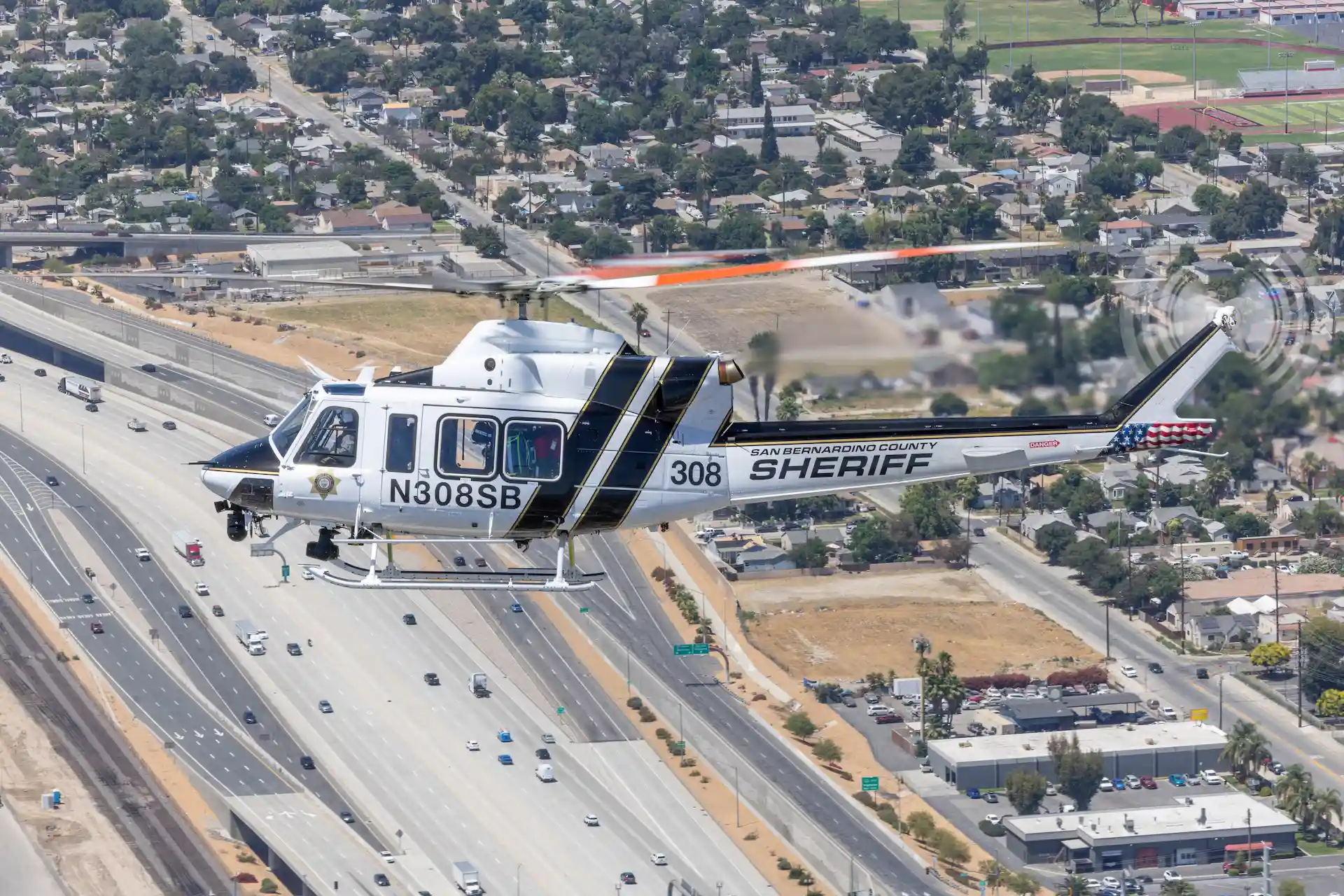
Positive Experience
When questioned on his opinion of the 412EPX, Anderson is very positive. He cited the simplicity of the caution alert system as a major plus, eliminating the need to look down at a panel on the center pedestal with a multitude of alarm lamps to determine the cause of an alarm. The new CAS system is in the pilot’s line of sight and details the specifics of any alert. Something that he is still coming to grips with is the variable nature of the electronic power limits. “Instead of a gauge that has an unchanging yellow arc and red limit, the yellow arc in the 412 constantly changes as you pull power so you have to learn where you can anticipate it is going to be. I’m digging the 412 though,” he enthused. “Even though I’ve got the most time in it, it’s early days and I’m still a baby pilot. I really love having the AC, I’ve taken it to various altitudes at what I call our ‘fighting weight’ and it does everything we want it to. I know it can do more than I’m comfortable with yet but that’s only because I’m still learning the ship. I love flying helicopters, doing patrols, chasing and finding bad guys but there’s nothing like working the rescue shift because you have such a significant and immediate impact on somebody.”
 HOME
HOME



